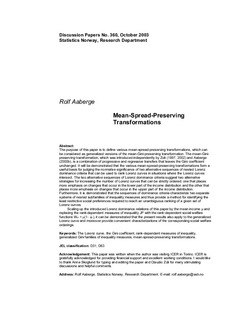Mean-spread-preserving transformations
Working paper

Åpne
Permanent lenke
http://hdl.handle.net/11250/180443Utgivelsesdato
2003Metadata
Vis full innførselSamlinger
- Discussion Papers [1003]
Sammendrag
Abstract:
The purpose of this paper is to define various mean-spread-preserving transformations, which can
be considered as generalized versions of the mean-Gini-preserving transformation. The mean-Ginipreserving
transformation, which was introduced independently by Zoli (1997, 2002) and Aaberge
(2000b), is a combination of progressive and regressive transfers that leaves the Gini coefficient
unchanged. It will be demonstrated that the various mean-spread-preserving transformations form a
useful basis for judging the normative significance of two alternative sequences of nested Lorenz
dominance criteria that can be used to rank Lorenz curves in situations where the Lorenz curves
intersect. The two alternative sequences of Lorenz dominance criteria suggest two alternative
strategies for increasing the number of Lorenz curves that can be strictly ordered; one that places
more emphasis on changes that occur in the lower part of the income distribution and the other that
places more emphasis on changes that occur in the upper part of the income distribution.
Furthermore, it is demonstrated that the sequences of dominance criteria characterize two separate
systems of nested subfamilies of inequality measures and thus provide a method for identifying the
least restrictive social preferences required to reach an unambiguous ranking of a given set of
Lorenz curves.
Scaling up the introduced Lorenz dominance relations of this paper by the mean income ì and
replacing the rank-dependent measures of inequality JP with the rank-dependent social welfare
functions WP = ì(1- JP), it can be demonstrated that the present results also apply to the generalized
Lorenz curve and moreover provide convenient characterizations of the corresponding social welfare
orderings. Keywords: The Lorenz curve, the Gini coefficient, rank-dependent measures of inequality,
generalized Gini families of inequality measures, mean-spread-preserving transformations.